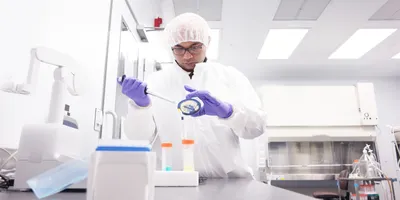Biosafety in the lab depends on more than written procedures—it relies on people. In this Q&A, Brian Leroux, senior manager of environmental, health, and safety at ATCC, explains why overconfidence and overreliance on SOPs can leave labs vulnerable, and how thoughtful engagement, ongoing training, and presence in the lab can strengthen biosafety culture. He shares practical ways lab managers can help staff think critically about risks, take ownership of safety practices, and adapt to emerging technologies without compromising protection.
Q: From your perspective, what are the most common but overlooked biosafety risks that labs face today?
A: In my experience, one of the biggest risks is an overreliance on standard operating procedure (SOP) documents alone to guide staff behavior. The real “burdens” of biosafety controls often fall on the shoulders of the laboratorians who are in the lab, day-in-and-day-out. It’s essential that they be given the tools to critically think about the task they are performing and the biosafety hazards they may encounter. Doing so will not only help them respond quickly and effectively when needed, but they may also have creative ideas on how to eliminate the hazards altogether.

Brian Leroux
If, however, we leave it to SOP documents alone to teach the staff, they may not effectively and completely understand the risks of their work or how to protect themselves. When an unexpected incident occurs, they’re likely to be slower and less effective in their response. We cannot just give them an SOP and expect that to be enough—there needs to be ongoing (instructor-led) training to foster critical thinking and deep understanding of laboratory equipment, reagents, and practices.
Another risk factor that is often overlooked is overconfidence in the protection provided by both laboratory equipment and personal protective equipment (PPE). If staff don’t understand their laboratory equipment or how their PPE protects them, they’re unlikely to understand what the limitations are and how failures may arise.
A classic example of this is the biosafety cabinet—a piece of equipment whose protective function is only as good as the user’s technique. Staff often expect the cabinet to automatically protect them from their samples and vice versa. Some users may not realize that the protective functionality of the cabinet is heavily influenced by their own behavior. The protective curtain of air flowing at the front of the cabinet, for example, can easily be disrupted by moving too fast, blocking outflow vents, and other subtly disruptive habits that leave users and their samples vulnerable to contamination.
Q: Why is cross-contamination such a persistent issue in laboratories, even with established protocols in place?
A: There are a multitude of reasons cross-contamination can occur, but in my experience, it’s often human error. And, frequently, it’s human error that stems from overconfidence around commonly used equipment.
Rarely do you actually dive into root cause assessment on biosafety or contamination events and find that equipment failure was the sole factor. You often find that because staff have a routine familiarity with a piece of equipment, they just forget about small details like the importance of pipetting slowly or careful movements in the biosafety cabinet.
Human error is difficult to eliminate completely, but it would be a mistake to just write these events off as unavoidable. Many of the behaviors and thought processes that lead to these errors can be corrected with thoughtful education.
Q: What practical steps can lab managers take to strengthen their biosafety culture and reduce hidden risks?
A: I think the same advice I have for safety and health professionals applies to lab managers as well: If you want to build a culture where biosafety is a priority and at the forefront of your staff’s minds, you have to be present and trusted by your staff, and continuously advocate that their health and safety come first. You have to get to know your staff on a personal level and become a person they can confide in when difficult work situations arise.
Additionally, you have to be observant. It’s easy for laboratorians to overlook small details that nonetheless have a big impact on biosafety. It’s important that lab managers be continually engaged in the work their people are doing, both to set a good example and to observe the lab’s evolving habits. If you’re there and engaged, you’re more likely to see where errors can happen and prevent them before they can occur.
Lab Safety Management Certificate
The Lab Safety Management certificate is more than training—it’s a professional advantage.
Gain critical skills and IACET-approved CEUs that make a measurable difference.
Q: What are some best practices for monitoring and verifying that biosafety protocols are being followed consistently?
A: Here, too, I think the best practice is to simply be engaged in your laboratory environment. That doesn’t mean constantly hovering and questioning your staff, but rather to lead with curiosity about their work. A “Hey, that’s cool, can you tell me more about how it works?” can be the start of very interesting conversations, ones that both facilitate better relationships and potentially highlight where biosafety challenges exist.
From a health and safety perspective, some of the coolest interactions that I’ve had with laboratorians started with asking questions about their studies and the processes they were using. People really appreciate it when you take the time to learn about their passions.
To me, that's the best way to ensure biosafety protocols are being followed: just be present. It all starts there in the lab.
Q: How do new and emerging technologies (automation, high-throughput systems, advanced culture techniques) change the biosafety risk landscape?
A: New and emerging technologies are rapidly increasing the scale and speed of biological work, and certainly pose new, unexpected risks. When bringing in a new technology, you must assess its functionality, how it will integrate into existing laboratory spaces, and whether or not it introduces new contamination and biosafety risks. We take a structured, proactive approach to align internal protocols with evolving regulatory guidance and tap into our “in-house” expertise to identify hazards, evaluate exposure pathways, and assess risk impact.
It’s worth noting here, too, that this is where a close relationship with laboratory staff can be really helpful. Biosafety isn’t always top of mind for them, and they may not think to alert health and safety folks that a new piece of equipment has arrived. But if you’re there talking to them about their work, you’re more likely to recognize when something new has arrived and how it's going to be used. This allows you to more accurately assess biosafety risks and more effectively protect your people.
Q: How can lab managers encourage staff to take ownership of biosafety rather than viewing it as just a compliance requirement?
A: It really comes down to working with staff to develop and understand biosafety processes, rather than just telling them what to do. Ask them questions, get their input, and value their perspective. This is not only a great way to develop buy-in, but it’s also essential to developing effective biosafety controls and procedures.
For example, I like to explain the controls and procedures that I think will protect them best, and then I ask them, “What do you think? Does this impair your ability to work? Am I creating more challenges than I’m solving?” I’m looking at these problems from a different perspective and could be overlooking important details that may be far more important to them.
By asking for their opinions, you’re inviting them into the process of protecting their own health and safety, and that fosters buy-in. I think that’s when you really start to build a true safety culture, when staff at all levels are actively involved in protecting each other.
There’s also the benefit of helping staff understand that biosafety procedures are not just arbitrary hurdles that make life harder. A lot of people just want to know why they must take extra steps, why they must wear certain pieces of PPE. They don’t like it; it’s a pain and takes valuable time. But if you take the time to explain the rationale behind your approach, and if you offer them a voice in shaping it, they begin to see how these things protect them and support their work. That goes a long way towards instilling a sense of ownership among staff.
Q: Anything else to add?
A: Just to summarize that I believe good biosafety requires a dedicated, personal touch. Be present, get to know the people you’re protecting, and work with them to develop biosafety protocols that they both understand and appreciate. If you don’t explain your rationale and you don’t involve them in the process, you run the risk of implementing the wrong protections and having the staff feel policed, rather than protected. Good biosafety is not done in a vacuum; it’s done as a group, for the group.
Brian Leroux is the senior manager of environmental, health, and safety at ATCC, a global biological resources and standards organization, where he oversees laboratory biosafety, chemical hygiene, industrial safety, and regulatory compliance at ATCC’s headquarters in Virginia and two of ATCC’s R&D facilities in Maryland. Brian brings more than 13 years of experience to his role, having previously worked in environmental health & safety at the Battelle National Biodefense Institute. He holds a degree in biology from Central Michigan University.













